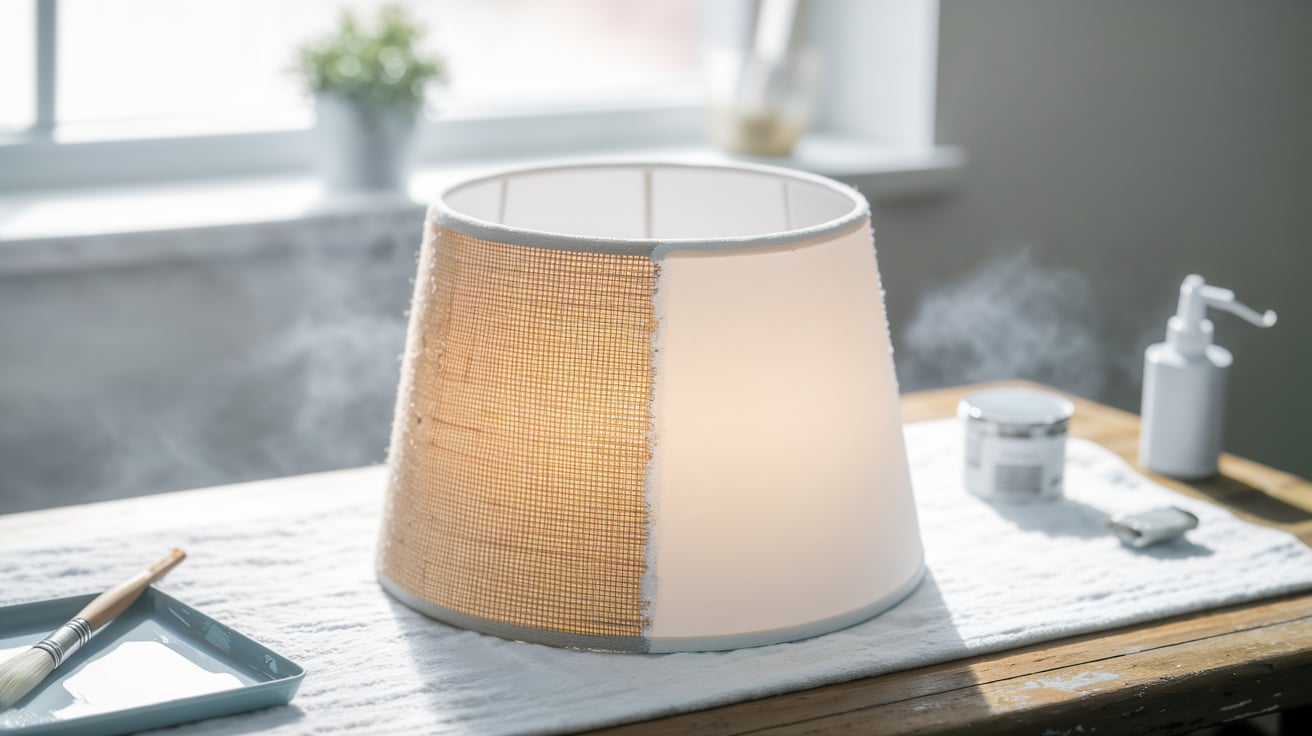Do you stare at plain lampshades in your home wanting more color? Most store-bought shades lack personality and style. Many homeowners settle for boring options that don’t match their decor.
Good news! You can create custom lampshades with basic supplies and simple techniques. Painting your lampshades offers a budget-friendly way to refresh your space and add personal touches to your home.
This guide will show you exactly how to paint lampshades like a pro. You’ll learn which paints work best, how to prep your shade, and tricks for clean, lasting results. By following these steps, you’ll turn ordinary items into statement pieces that guests will notice.
Let’s start creating your perfect painted lampshade!
Why You Should Consider Redoing Your Lampshade?
When you change a lampshade, you change how light fills your room. The right shade can soften harsh lighting or bring warmth to cold spaces. A new shade can also add color that ties together other elements in your room.
Cost is another good reason to redo rather than replace. New designer lampshades can be costly. With some basic materials and a few hours of time, you can create custom pieces for much less money.
Your home should reflect your taste and style. Store-bought shades often look the same from house to house. By redoing your lampshade, you add truly unique touches that make your space feel more personal.
Step-by-Step Guide to Painting a Lampshade
Old lamps can look new again with some paint and care. This guide shows you how to fix up both the base and shade of your lamp. You don’t need fancy skills or tools to get good results.
By following these steps, you can change a dull lamp into a fresh home accent. Let’s get started with bringing your old lamp back to life.
Tools and Materials Required for Painting a Lampshade
| Tool | Purpose |
|---|---|
| Spray Booth or Well-Ventilated Space | For safety when using lacquer and spray paint |
| Dust Mask | Protects from fumes while spraying |
| Drop Cloth or Plastic Sheet | Covers workspace and prevents overspray damage |
| Painter’s Tape | Masks off parts not to be painted |
| Synthetic Paintbrush | For applying one-step paint on lampshades |
| Water Mister | To dampen fabric lampshades before painting |
| Lazy Susan (Optional) | Makes rotating the lamp while painting easier |
| Sandpaper (400 Grit) or Paper Grocery Sack | For smoothing fibers after painting |
| Sponge Brush | For applying gilding size or lacquer inside shade |
| Material | Purpose |
|---|---|
| One-Step Paint (Bauhaus Buff or Ballet White) | For painting lampshades, metal, and plastic |
| Clean Slate | Removes dirt and old finishes before painting |
| Lacquer Spray (Pink or Desired Color) | For glossy finishes on lamp bases |
| Water | Helps thin paint for smoother application |
| Gilding Size and Gold Leaf (Optional) | For adding metallic finish inside the lampshade |
| Masking Film or Plastic Sheet | Protects electrical parts during painting |
Step 1: Clean the Lamp Base
Start with a clean lamp base. Apply a small amount of clean slate to a rag. Wipe down the lamp base fully to remove any dirt, grime, or oils. This helps the paint stick well to the surface. Make sure to clean all parts of the lamp, such as glass, ceramic, or plastic sections.
Step 2: Prepare the Lamp Base for Painting
Protect the socket and cord from paint using painter’s tape. Work in a space with good air flow or outdoors. Use a drop cloth to cover your work area. Wear a mask to protect yourself when using spray products.
Step 3: Apply Lacquer to the Lamp Base
Shake the lacquer can for 3-4 minutes to mix it well. Hold the can about 6-7 inches away from the lamp. Begin at the top and work down to avoid drips.
Move smoothly to create an even coat. Apply 2-3 coats with 15-20 minutes of dry time between each. Let the lacquer set for at least 24 hours before you handle it.
Step 4: Prepare and Paint the Lampshade
Wipe the shade with clean slate, which works well for fabric or burlap. Spray the lampshade lightly with water to ready the fibers for paint. Mix one-step paint with 15-20% water to thin it so it soaks into the fabric better.
Hold the inside of the shade with your hand to keep its shape while painting. Use a synthetic brush to apply paint in smooth, even strokes. Let the first coat dry for 1-2 hours. You can smooth any raised fibers with fine sandpaper or a paper grocery sack. Add a second coat for full coverage.
Step 7: Final Touches
Take off the painter’s tape and put the lamp back together. Check for any spots you missed and touch them up. Now you can show off your new lamp that you fixed up yourself!
For a visual tutorial, refer to this video by Amy Howard at Home
Common Mistakes to Avoid When Painting Lampshades
Small errors can ruin your lampshade project. Knowing these common pitfalls will help you get better results on your first try:
-
Skipping the Cleaning Step – Dirt and grime can prevent paint from adhering.
-
Not Misting Fabric Shades – Dry fabric may absorb unevenly, causing streaks.
-
Using Too Thick Paint – Thick paint may create a rough texture or crack the shade.
-
Rushing Through Coats – Not allowing proper drying time can result in uneven coverage.
-
Neglecting Protective Measures – Failing to cover the inside or protect the base can lead to messy outcomes.
Final Tips for a Professional Finish
Small details make a big difference in your end result. These extra steps take just minutes but can help your painted lampshade look like it came from a high-end store:
- Check the Light Test – Turn on your lamp in a dark room to spot any missed spots or thin areas that need touch-ups.
- Keep a Soft Touch – Apply gentle pressure when painting to avoid crushing or warping the lampshade structure.
- Use Proper Storage – Store extra paint in sealed containers for future touch-ups or to match other home items.
- Try a Clear Coat – A thin layer of clear sealant can help protect fabric shades and make them last longer.
- Watch for Drips – Check the bottom edges of the lampshade often for paint build-up that can form drips.
Conclusion
Painting lampshades offers a simple way to refresh your home decor. With basic supplies and some care, you can create custom lighting that fits your style. Remember to clean thoroughly, use thin coats, and allow proper drying time between steps.
The process we’ve outlined works for many types of lampshades and bases. The key is patience—rushing often leads to poor results. By following these steps and avoiding common errors, you can turn old, plain lamps into fresh focal points.
Next time you see a tired lamp at a thrift store or in your storage closet, think twice before tossing it out. With these painting methods, you now have the skills to give it new life and make it truly yours.
Frequently Asked Questions (FAQs)
1. What Kind of Paint Do You Use on a Lampshade?
For lampshades, use fabric paint or acrylic paint mixed with textile medium. Chalk paint works well on paper or fabric shades. Always thin paint with water for best results.
2. Is it Safe to Paint a Fabric Lampshade?
Yes, it’s safe to paint fabric lampshades if you use proper paints. Make sure the lamp is unplugged while painting and let it dry fully before use.
3. Can You Paint Lamp Shades with Fusion Paint?
Yes, you can use Fusion paint on lampshades. It sticks well to most surfaces and creates a smooth finish. Thin it slightly for fabric shades.













